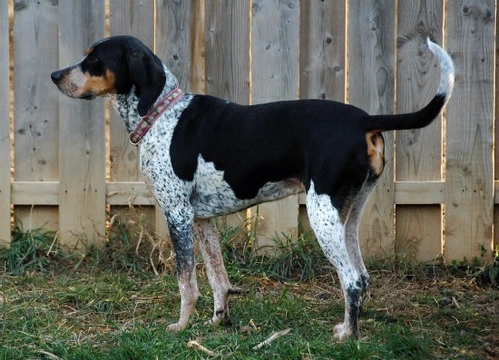Pets
Pets for studWanted petsBreedersAccessories & services
Knowledge hub
Support
Support & safety portal
More information on the Bluetick Coonhound
The Bluetick Coonhound is one of several American dog breeds that fall into the Coonhound grouping, but are each recognised as individual breeds in their own right. They are handsome, relatively large dogs that can stand up to 30” tall at the withers, and weigh up to 36kg. Their name comes from the colouration of their fur, being mottled black on white in a “ticked” pattern, making the overall appearance of the dog appear dark navy blue. They have short, glossy coats and long pendulous ears, similar to those of many other scent hound breeds, of which the Bluetick Coonhound is one of the best.
Popular and a common sight within breed shows in certain areas of America, the Bluetick Coonhound is only recently beginning to become seen in significant numbers in other areas of the world, and is now imported into the UK as well as other parts of Europe. If you are wondering if the Bluetick Coonhound makes a good choice of pet and can live happily within a domestic environment, in this article we will look at the core traits of the breed in more detail. Read on to learn more.
What is their temperament like?
The Bluetick Coonhound is a hardy, fit and athletic dog that thrives on having a job and a role to fulfil, and will soon become bored and morose without any purpose to their lives. They are widely considered to be more amenable to handling and family life than many other of the various Coonhound breeds, and providing that they are happy and secure within their surroundings, are very personable, outgoing and loving dogs.
Do they require a lot of exercise?
Like all of the Coonhound breeds, the Bluetick Coonhound thrives on being on the go, and needs as much mental stimulation as they do physical. They like to be outdoors and go for long walks, runs and hikes, and also like to range and run and play off the lead. They also love to have a direction and a role to fulfil, and for this reason are often very well suited to a wide range of canine sports, including agility, scenting and tracking.
Are they easy to train?
The Bluetick Coonhound is a clever, alert dog that can learn fast simply through observation, and so care should be taken to ensure that they do not inadvertently pick up bad habits! They are, however, considered to be a fairly challenging dog to train, and require an experienced owner who can deal with potential challenges and a sometimes stubborn temperament! They are very quick to bark and will sometimes bark incessantly for no obvious reason, and so “voice training” the dog to curb this trait is important, to avoid the potential for the dog to drive everyone around them to distraction!
They are very intuitive and once properly trained, easy to direct and manage, and always keen to learn and execute new skills.
Do they have a strong prey drive?
The Bluetick Coonhound is first and foremost a hunting dog, which naturally use their strong sense of smell to seek out trails and pursue prey. However, when this trait is harnessed and controlled, they are very responsive to commands and can display good recall and high levels of obedience.
Do they get on well with other pets?
The Bluetick coonhound is generally personable with other dogs when properly socialised, but they can be prone to dominance and will not tolerate being annoyed or messed around by other dogs!
It can be difficult to keep a Bluetick Coonhound housed with smaller pets, due to their strong prey drive, but this feat is by no means impossible with correct training and management.
Are they well suited to domestic life?
The Bluetick Coonhound is not one of the best dogs to keep in a home with other, non-canine pets, but they are on the other hand excellent with children of all ages. They are playful but gentle with smaller children, and will moderate their behaviour to ensure that small kids do not become knocked over or hurt.
They do have something of a reputation for eating anything and everything, and will soon help themselves to the contents of the bin if this is not kept out of their reach, something that requires careful management!
They are also very vocal dogs, which may prove to be a problem if you live in close quarters with your neighbours, as once they get going with making a noise and a fuss, they are very reluctant to let up! The breed is also one that is sometimes wrongly mistaken for being aggressive, as they tend to be excitable around strangers as well as bold and not very mindful of people’s personal space, often sniffing strangers at close quarters while howling and yipping around them! However, this is an excitable trait rather than a truly aggressive one, and providing that you get the chance to explain this to people your dog may meet, does not pose any genuine problem.



